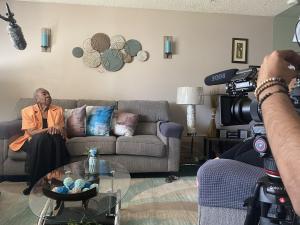Hope Floats: After the Windsor Park film, talks continue about the future

By Mike Weatherford
The students had to finish their film and move on. But the William S. Boyd School of Law at UNLV continues to be part of talks about the future of the troubled Windsor Park neighborhood.
Boyd Law faculty including professor Frank Fritz and students are taking part in discussions between state Senator Dina Neal and the Lincoln Property Company, which in August closed on 86 acres it plans for light industrial development next to Windsor Park. After the documentary (Windsor Park: The Sinking Streets) debuted last year, an attorney for the developers reached out to meet with Neal.
“I’m so grateful to professor Fritz because I was like, “This is becoming a lot,’” Neal says. “And he’s just like, ‘We can do this.’”
A zoning change allowing industrial use of the 86 acres dashed hopes for Neal’s first choice: a new residential neighborhood next to Windsor Park, with its remaining residents moved into new houses there.
But Fritz and Neal say the attention created by the student film helped make the developers sympathetic to improvements and proposals. Among them: neighborhood access to quality job opportunities and recreational park improvements. “I’m grateful Lincoln Property and the City of North Las Vegas are willing to talk to us and offer these things,” Fritz says.
Before the law school’s involvement, Neal says she felt like her efforts were seen by North Las Vegas officials as, “Why do you keep digging up dirt and making us look bad?” And I was like, ‘Am I though? I’m trying to help a neighborhood that’s been in a [poor] condition for the past 25 or 30 years. And it matters to me, and it should matter to you.’”
When Windsor Park started building out in 1964 in an area near Martin Luther King Boulevard and Carey Avenue, Las Vegas was still actively segregated. The 48 acres, with room for 241 homes, created an opportunity for Black home ownership in an era when blatant “red lining” for home loans prevented minority ownership in most of the city. “These were the first homes for African American families, the majority of them military families,” Neal says.
But the subdivision was built over geologic faults and an aquifer. The homes began to sink as groundwater was pumped out.
By 1988, the Department of Housing and Urban Development estimated it would cost $12 million to $14 million to move the affected residents. But the City of North Las Vegas moved the number closer to $5.4 million.
In 1994, about 45 of the residents accepted offers to move into nearby homes built for them. But Neal says the new homes were “almost like a mobile home kind of setup” and residents “didn’t like the way they were built.” Within a year, paint started peeling and home warranties began to expire. “But yet their mortgage was rolled over to these homes, and they were just out of luck,” Neal notes, so other residents said no to that move.
In 1997, the city offered $50,000, later raised to $100,000, toward new houses, which was enough to encourage another 43 residents to move. But others felt they weren’t young enough or in any financial position to take on a new mortgage.
As the situation evolves, “I’m just trying to keep my promise to the residents,” Neal says, trying to “move the needle forward for these families so that they didn’t stay in a state of invisibility.”
“You do what you can to fix the larger problem in pieces,” Fritz says. “Maybe in a step- by-step way, we can get justice for people in Windsor Park.”
“One of the things law school offers is perspective on policy and policy-making and local government,” says Sebastian Ross, the recent law school graduate who was the documentary project’s first research assistant.
It became “a good lesson,” he says, in seeing how state, federal and local governments interact and “how they respond to each other with complex situations such as what we’ve seen with Windsor Park. I think this project really highlighted how complex that can be, and how important it is to produce thoughtful consideration when trying to help people out.”
---
Related: Windsor Park: That Sinking Feeling